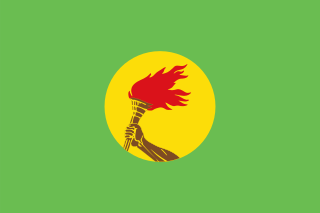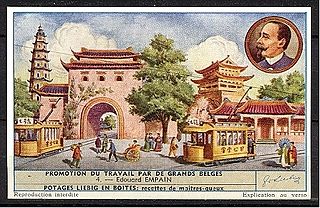| |||||
| Decades: | |||||
|---|---|---|---|---|---|
| See also: | History of Zaire | ||||
The following lists events that happened during 1976 in Zaire .
| |||||
| Decades: | |||||
|---|---|---|---|---|---|
| See also: | History of Zaire | ||||
The following lists events that happened during 1976 in Zaire .
| Date | event |
|---|---|
| Minière des Grands Lacs Africains (MGL) merges with SYMETAIN to create the Société Minière et Industrielle du Kivu (SOMINKI). [1] |

Zaire, officially the Republic of Zaire, was the name of the Democratic Republic of the Congo from 1965 to 1997. Zaire was located in Central Africa and was, by area, the third-largest country in Africa, and the 11th-largest country in the world. With a population of over 23 million inhabitants, Zaire was the most populous officially Francophone country in Africa, as well as one of the most populous in Africa.

Mobutu Sese Seko Kuku Ngbendu wa za Banga, commonly known as Mobutu Sese Seko or simply just Mobutu, was a Congolese politician and military officer who was the president of Zaire from 1965 to 1997. He also served as Chairman of the Organisation of African Unity from 1967 to 1968. During the Congo Crisis, Mobutu, serving as Chief of Staff of the Army and supported by Belgium and the United States, deposed the democratically elected government of left-wing nationalist Patrice Lumumba in 1960. Mobutu installed a government that arranged for Lumumba's execution in 1961, and continued to lead the country's armed forces until he took power directly in a second coup in 1965.

The Treaty of Saginaw, also known as the Treaty with the Chippewa, was made between Gen. Lewis Cass and Chief Mash Kee Yosh, Chief John Okemos, Chief Wasso and other Native American tribes of the Great Lakes region in what is now the United States, on September 24, 1819, proclaimed by the President of the United States on March 25, 1820, and placed in law as 7 Stat. 203.

The DR Congo national football team, recognised by FIFA as Congo DR, represents the Democratic Republic of the Congo in men's international football and it is controlled by the Congolese Association Football Federation. They are nicknamed Les Léopards, meaning: The Leopards. The team is a member of FIFA and the Confederation of African Football (CAF).
The Province of the Anglican Church of the Congo is a province of the Anglican Communion, stretching over the Democratic Republic of the Congo and the Republic of the Congo.
The Zaire Use, also called Zairean Rite, officially the Roman Missal for the Dioceses of Zaire, is a Congolese liturgical use of the Roman Rite within the Catholic Church. Approved by the Vatican in 1988, it contains many elements from the Ordinary Form of the Roman Rite, but also incorporates elements from sub-Saharan African culture, particularly Congolese, including a number of inculturated liturgical modifications.
Shanga is a Mande language of Nigeria.
Kyenga, is a Mande language of Nigeria and Benin. Usage is declining, and the Kyenga are shifting to Hausa in Nigeria and Dendi in Benin.

Malik Jamaal Zaire is an American media personality and former collegiate football quarterback. He currently works for the sports media company Overtime as on-air talent and as a producer, as well as a color commentator for college football games on the CBS Sports Network. He played college football at Notre Dame, before transferring to Florida as a graduate transfer.
Kasaloo Kyanga was a Congolese musician, guitarist, and composer. Kyanga's compositions, including the hit song "Masafa Marefu", composed with Tancut Almasi Orchestra, continue to be performed by musicians. His other hit songs include "Nimemkaribisha Nyoka", "Butinini", "Kashasha", and "Kambwembwe".
Kyanga may be:
The Compagnie Minière des Grands-Lacs (MGL) was a Belgian mining company active in the Belgian Congo and then in the Democratic Republic of the Congo. It was established in 1923 and in 1976 merged with other companies into the Société Minière et Industrielle du Kivu (SOMINKI). The company was active in the eastern regions of Maniema and Kivu, with its main center at Kamituga in today's South Kivu. It extracted gold, tin and other minerals.
The Twangiza-Namoya gold belt is a belt of gold deposits in the east of the Democratic Republic of the Congo. Artisanal working of alluvial deposits dates back to the 1920s. More systematic exploration and exploitation took place in the colonial era and continues up to the present, although civil war and militia attacks have periodically disrupted operations and have caused several changes of ownership of the concessions.
The Société Minière et Industrielle du Kivu (Sominki) was a privately held mining company of Zaire. It operated gold and tin mines, mostly in South Kivu province, between 1974 and 1997. The acquisition of its mining assets by Banro Corporation of Canada was complicated by the First Congo War in 1996–1997, followed by expropriation of the mines by the new Democratic Republic of the Congo (DRC) government. Eventually Banro gained the right to exploit the gold mines.

The Empain group was a loose grouping of companies founded by Édouard Empain (1852–1929) of Belgium and controlled by the Empain family. From 1881 until merging with Schneider & Cie in 1969, the companies engaged in a broad range of activities including tramways, railways, electricity generation, construction and mining. The main areas of activity were Belgium and France, but the group also pursued opportunities in Russia, Egypt, China and elsewhere, and played a large role in the development of the eastern Belgian Congo.
The following lists events that happened during 1932 in the Belgian Congo.
The following lists events that happened during 1964 in the Republic of the Congo (Léopoldville).
The following lists events that happened during 1969 in the Democratic Republic of the Congo.

This article provides details of international football games played by the Zaire national football team from 1971 to 1997, when the Democratic Republic of the Congo was named Zaire.
{{citation}}: CS1 maint: location missing publisher (link)